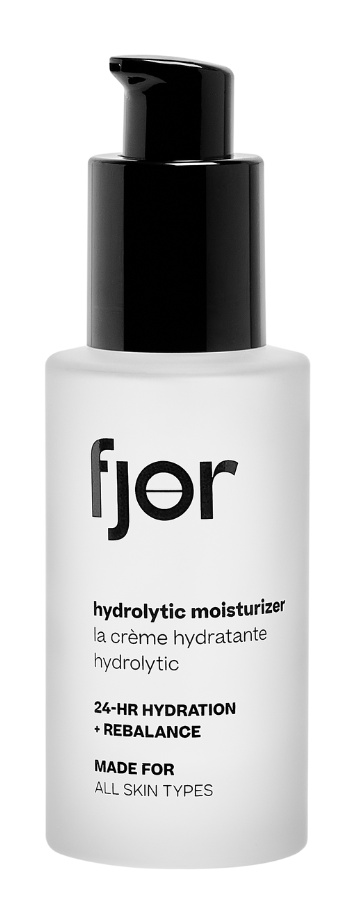
Hydrolitic Moisturizer
Highlights
Key Ingredients
Skim through
| Ingredient name | what-it-does | irr., com. | ID-Rating |
|---|---|---|---|
| Glycerin | skin-identical ingredient, moisturizer/humectant | 0, 0 | superstar |
| Aqua | solvent | ||
| Xylitol | moisturizer/humectant | goodie | |
| Pentylene Glycol | solvent, moisturizer/humectant | ||
| Imperata Cylindrica Root Extract (Japanese Blood Grass Root Extract) | moisturizer/humectant | goodie | |
| Carbomer | viscosity controlling | 0, 1 | |
| Tromethamine | buffering | ||
| Protease | |||
| PEG-8 | moisturizer/humectant, solvent | ||
| Calcium Chloride | viscosity controlling |
fjor Hydrolitic MoisturizerIngredients explained
- A natural moisturizer that’s also in our skin
- A super common, safe, effective and cheap molecule used for more than 50 years
- Not only a simple moisturizer but knows much more: keeps the skin lipids between our skin cells in a healthy (liquid crystal) state, protects against irritation, helps to restore barrier
- Effective from as low as 3% with even more benefits for dry skin at higher concentrations up to 20-40%
- High-glycerin moisturizers are awesome for treating severely dry skin
Good old water, aka H2O. The most common skincare ingredient of all. You can usually find it right in the very first spot of the ingredient list, meaning it’s the biggest thing out of all the stuff that makes up the product.
It’s mainly a solvent for ingredients that do not like to dissolve in oils but rather in water.
Once inside the skin, it hydrates, but not from the outside - putting pure water on the skin (hello long baths!) is drying.
One more thing: the water used in cosmetics is purified and deionized (it means that almost all of the mineral ions inside it is removed). Like this, the products can stay more stable over time.
A type of sugar that's part of a moisturizing trio called Aquaxyl. You can read more about its magic properties at xylitylglucoside.
A multi-functional, silky feeling helper ingredient that can do quite many things. It's used as an emulsion stabilizer, solvent and a broad spectrum antimicrobial. According to manufacturer info, it's also a moisturizer and helps to make the product feel great on the skin. It works synergistically with preservatives and helps to improve water-resistance of sunscreens.
A subtropical plant that thrives in flooded environments and is claimed to give excellent long-term moisturizing effects. Its hydrating ability is due to the chemical composition of the rhizomes that contain natural osmoprotective compounds such as 3-dimethylsulfoniopropionate (DMSP), potassium, starches, and sugars.
Osmoprotective compounds are interesting, skincare-wise, as they are thought to be able to increase intracellular osmosis, meaning water is drawn into the skin cells. According to the efficacy data from the manufacturer, 2% of ABS Imperata Cylindrica Extract (the trade name of the diluted version of the root extract) is able to increase the level of skin moisturization by almost 45%, which is 88% more effective than the untreated control.
This all sounds great, however, in terms of comparative effectiveness, Imperata Cylindrica came up somewhat short in the study published in the Journal of cosmetic dermatology. They compared four hydrogels with different moisturizer actives and although all the formulas did hydrate the skin, the one with Imperata Cylindrica extract performed less well than the same formula with urea or sugar-based hydrating trio, called Aquaxyl.
Still, it is a skin goodie with nice moisturizing properties, so if you are after skin hydration, it is a good one to spot on the INCI list.
A big molecule created from repeated subunits (a polymer of acrylic acid) that magically converts a liquid into a nice gel formula. It usually has to be neutralized with a base (such as sodium hydroxide) for the thickening to occur and it creates viscous, clear gels that also feel nice and non-tacky on the skin. No wonder, it is a very popular and common ingredient. Typically used at 1% or less in most formulations.
It's a little helper ingredient that helps to set the pH of the products to be right. It has an alkaline pH and can neutralize acidic ingredients.

A smallish polymer molecule (created from repeated units of Polyethylene glycol, aka PEG) that's used as a solubilizer and viscosity control agent.
It is a clear, colorless liquid that is water-soluble and water-binding (aka humectant) and can help to solubilize sparingly-water soluble things (e.g. vanilla, perfumes) into water-based formulas. Thanks to its water-binding ability, it also prevents the drying out of formulas, especially when combined with the fellow hygroscopic agent, sorbitol.

You may also want to take a look at...
| what‑it‑does | skin-identical ingredient | moisturizer/humectant |
| irritancy, com. | 0, 0 |
| what‑it‑does | solvent |
| what‑it‑does | moisturizer/humectant |
| what‑it‑does | solvent | moisturizer/humectant |
| what‑it‑does | moisturizer/humectant |
| what‑it‑does | viscosity controlling |
| irritancy, com. | 0, 1 |
| what‑it‑does | buffering |
| what‑it‑does | moisturizer/humectant | solvent |
| what‑it‑does | viscosity controlling |





